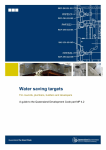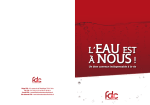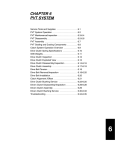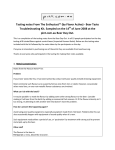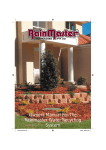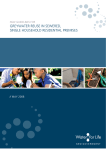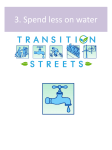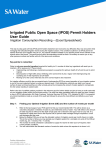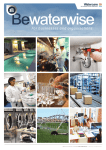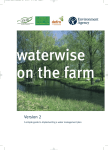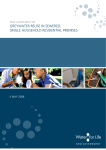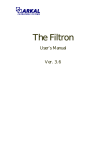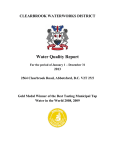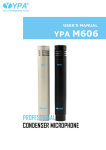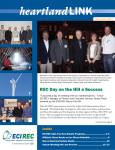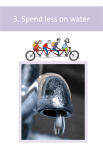Download Chapter Two: Water - Sustainable Homes & Communities
Transcript
Chapter Two: Water CHAPTER 2 Why save water? T housands have lived without love - not one without water. W. H. Auden Australia is the driest inhabited continent on Earth yet we have one of the highest per capita water consumption rates in the world. Two-thirds of the world’s population use less than 60 L (litres) of water per person per day, while the typical Australian uses almost twice that amount during a single shower! There is a lot of water in the world, but very little is available for us to use. In fact, only 2.5% of all the water on Earth is fresh, with most of this fresh water locked up in ice caps. Rivers and lakes Groundwater/soil bound Glaciers/permanent snowfields Fresh water (2.5%) Available fresh water (0.3%) Salt water (97.5%) The majority of the earth’s water (97.5%) is found in oceans, saltwater lakes and rivers. Just 2.5% is fresh – the volume that would fill a standard measuring cup. Of this fresh water, 68.9% is tied up in ice and snowfields, with a further 30.8% being groundwater or bound in soil/ permafrost. Just 0.3% (about one and a half tablespoons) is readily accessible to us in lakes and rivers. Composition of the world’s water Although water is a renewable resource, we can still run out of fresh water if it’s used faster than it’s replaced by rainfall, or if we pollute it so it’s no longer useable. page 14 . . . . . . Transition Streets . . . WATER It’s important to make every drop count. While our governments can build more dams, these structures put enormous pressure on our environment and economy. The construction of dams can destroy wildlife habitat (including the homes of endangered and threatened species) and take away land that could otherwise be used for food production. Desalination plants – which convert seawater into drinking water – use huge amounts of electricity and the costs of infrastructure, maintenance and operation to society are substantial. Climate change is also likely to effect our water resources. The Intergovernmental Panel on Climate Change (IPCC) 5th Assessment Synthesis Report (2014), states that we are likely to see more droughts and floods with increasing climate change. It also states: ‘Climate change is projected to reduce renewable surface water and groundwater resources in most dry subtropical regions, intensifying competition for water among sectors.’ Being more sustainable with how we use our existing precious water resources is therefore crucial for ensuring access to water for everyone well into the future. The good news is we can all start taking water wise actions today, house by house, street by street. Saving water not only helps protect our environment, it’ll save you money. You can cut your water usage costs and, by using less hot water, reduce your energy bill too! As a nation, we are becoming more water conscious. For example, water restrictions were introduced in Southeast Queensland in 2005 due to dwindling dam supplies. Prior to these restrictions, average daily use per person was 230 litres. During the drought years, this decreased to 140 litres per day, and by early 2013, when water restrictions were removed, the daily usage per person was180 litres. Even though restrictions were no longer in place, people continued to use some of the water saving techniques they’d used during the drought. . . . page 15 CHAPTER 2 How much do you use? You can work out your daily consumption by checking your water bills. Most bills have a bar graph showing your average daily usage, and some give comparisons with the local residential average. As water usage can vary significantly between seasons, it is useful to have a year of usage information. Don’t forget, water usage is provided on your bill in kilolitres, not litres. One kilolitre equals 1,000 L. Use your recent water bills to fill in the table opposite. Example of graph and meter information on water bills: page 16 . . . . . . Transition Streets . . . WATER Worked example: Multiply column B by 1,000 A B C Usage period Average daily usage (kL) Average daily usage (litres) Bill 1 8 Mar - 6 Jun 0.33 Bill 2 6 Jun - 9 Sept 0.28 280 Bill 3 9 Sept - 16 Dec 0.34 340 Bill 4 9 Dec - 16 Mar 0.37 370 330 = (0.33 x 1000) 0.33 Average daily usage (for year) (.33 + .28 + .34 + .37) 4 330 Add all 4 bills and divide by 4 My water usage for the past year Usage period Average daily usage (kL) Average daily usage (litres) Bill 1 Bill 2 Bill 3 Bill 4 Average daily usage (for year) . . . page 17 CHAPTER 2 Keep track of your progress Now that you know your average daily usage, you can measure your reductions in water usage from here on. This can be done by reading your water meter regularly as you undertake water saving actions. Your water meter is generally found in your front yard, near your front boundary. If you have trouble finding it, phone your local water authority and they should be able to provide information as to its general location. There may be different styles of water meter in your area. The two common types are shown below. The meter on the left, shows water usage in kilolitres at the top of the meter. The five-digit number reads 01234 (i.e. 1,234 kilolitres, or 1,234,000 litres). The small clock meters count the litres in tenths, single litres, tens and hundreds of litres. The meter on the right shows the total kilolitres used, on the five-digit black on white number 00044 (i.e. 44 kL, or 44,000 L). The three-digit white on red numbers indicate the number of litres that have been used beyond the 44 kL (i.e. 714 L). page 18 . . . . . . Transition Streets . . . WATER Monitor your daily usage Use your meter to fill out the table below. You will need to take a reading once at the beginning and again at the end of the month. You can continue to take readings over the coming months and enter additional data to keep track of your progress. In the example below, 20,350 L (i.e. 390,350 minus 370,000) has been used over 30 days (i.e. 31 May – 1 May). The average daily usage can be calculated by dividing the total litres by the number of days (i.e. 20,350 L ÷ 30 days = 678 L per day). Worked example: Date of reading No. of days Litres on meter Total usage (litres) Average daily usage (litres) 1 May - 370,000 - - 31 May 30 390,350 20,350 678 You may want to track your usage more closely than monthly. If you want to record your meter reading weekly, try to check it on the same day and time each week. My water usage from now on Date of reading No. of days Litres on meter Total usage (litres) Average daily usage (litres) . . . page 19 CHAPTER 2 Saving water in and around the home Now that you know how much water you’re using, it’s important to understand where it’s being used and how to take small steps (or larger ones) to make big reductions. The chart below gives a typical breakdown of where water is used in the home. 2% 14% 25% Other Taps 15% Bath & shower Toilets 20% 24% Outdoor use Washing machine There are different ways of addressing the water issues around your home. Essentially, you can: •• use what you have more efficiently (don’t waste it, ensure you have water efficient fittings/appliances) •• use it more than once where appropriate (by redirecting it after use, collecting and reusing it, or collecting, treating and reusing it) •• collect your own rainwater (e.g., install a tank, redirect rainwater directly to where it’s needed). For some households it may be appropriate to use a combination of 2 or all 3 of these. The following pages discuss ways of looking (or relooking) at water use, and changing behaviours and/or water systems in our homes. page 20 . . . . . . Transition Streets . . . WATER 1. Fix leaks A lot of water is lost around the home due to dripping taps and leaking pipes. To detect a leak on your property, you need to not use any water in the home for at least three hours (a good time to do this is when everyone is going out). Ensure all your taps are turned off. Write down your meter reading when you leave and as soon as you return home. If no water has been used the reading should be the same. If the meter has moved, you have a leak that should be found and fixed. Leaks can usually be fixed by changing washers on dripping taps or repairing leaking toilet cisterns. To check your toilet, put a few drops of coloured food dye in the cistern. If it is leaking, coloured water will appear in the bowl between flushings.If you still have leaks after fixing your taps and toilets, there may be a leak elsewhere on your property possibly requiring the assistance of a plumber. My action plan to fix leaks Will do Have Done N/A FREE Check for leaks FREE - $ Change washers (if required) $$-$$$ Fix any remaining leaks (if required) . . . page 21 CHAPTER 2 2. In the bathroom Around half of household water usage usually occurs in the bathroom, the majority of which is used for showering. Shower and bath Old style shower heads use up to 25 L per minute, whereas a 3-star one uses 9 L per minute or less. Some showers can be purchased that use as low as 5.5 L per minute. On average Australians spend 7 minutes in the shower. It’s quite reasonable to have a good shower in less than 4 minutes – remember shorter showers can also save on energy bills associated with heating water. Do you know how long your showers are? Try using a shower timer to help. Could you replace some showers with washes instead? Using a basin of water to wash obviously reduces the amount of water used considerably, and sometimes may be all that’s needed. By choosing to have a shower over a bath, you will generally reduce your water use significantly. Baths typically use between 80 L and 200 L of water, whereas a 4-minute shower from a 3-star shower head will use no more than 36 L. For children bathing, try to keep baths only as deep as they need to be. Using a bucket to collect cold water in the shower while you wait for hot water to come through is a good way of collecting water for re-use. A hot water circulator can also be used. They are, however, around $600 to purchase, giving a 10–15k L saving per year (i.e. $20– $30 per year). Toilet A 4-star toilet can save the average home up to 35,000 L per year. These toilets use just 4.5 L for a full flush and 3 L for a half flush, while an old-style single-flush toilet typically uses 11 L of water in every flush. Replacing inefficient old toilets can be expensive; however, you can purchase small gadgets to reduce the volume used with each flush of an old-style toilet, which work by causing the toilet to flush for as long as the button is pressed. Alternatively, you can use small plastic bottles filled with water. With lids tightly screwed on, place bottles inside the cistern ensuring they do not cover water-flow holes or come into contact with moving parts. This will reduce the volume in the cistern where water can fill. Often in old large toilets the amount of water used to flush was far too much. Only try this if you have confidence, as a little experimenting may be required. Reduced cistern capacity should not affect adequate flushing. page 22 . . . . . . Transition Streets . . . WATER Basin taps Make sure you don’t leave the tap running while brushing your teeth, and consider shaving your face/legs before showering. Install a tap aerator and reduce flow rates from typical 12 L per minute to 5 L. Insulating pipes By insulating your hot-water pipes, you can avoid wasting so much water while you wait for hot water to flow through. My bathroom action plan Will do Have Done N/A FREE Measure shower rate (litres/minute) FREE - $ Replace showerhead/s FREE - $ Time your showers FREE Take shorter showers/shower less often FREE Shower rather than bath FREE Collect cold shower water FREE - $ Reduce toilet cistern capacity $$-$$$ Replace toilet with water-efficient one FREE Turn tap off when brushing teeth FREE Use basin when shaving $ Install tap aerator $$ Insulate hot-water pipes Other ideas: ___________________________________________________________ ____________________________________________________________________ ____________________________________________________________________ ____________________________________________________________________ . . . page 23 CHAPTER 2 3. In the laundry Between 14–20 % of all water consumed in the home occurs in the laundry. With the average family doing 274 loads of washing a year, using around 50 L of water per wash, there are many opportunities to reduce wastage and make savings. Washing machines vary significantly in how much water they use per wash: when adjusting for capacity, some use as much as 20 L per kilogram while others as little as 6 L. So when buying a washing machine, make sure it has at least a 4-star rating (WELS Label). Generally, front-loading washing machines are the most water and energy efficient. Buy the smallest washing machine you think you will need, e.g. an 8 kg machine is generally too large for a couple. There is now little price difference for washing machines up to 4.5-star rated and less efficient models. Try to familiarise yourself with your washing machine cycle options. Some settings provide the same cleaning power but with less water and energy. Check your user manual or contact the manufacturer. You can often adjust the water level to suit the size of the washing load – some new waterefficient models will do this automatically. Washing a full load in one cycle can save at least 10 L of water than washing the same clothes in two half-loads. Consider how often you really need to wash your clothes or towels. Often many items can be used more than once before being thrown in the washing basket, as we often wash things that don’t need it out of habit – if it doesn’t look or smell dirty, it may last another day! This will also obviously save you unnecessary work. My laundry action plan Will do Have Done N/A $$$ Buy water-efficient washing machine FREE Become familiar with efficient cycle options FREE Wash only full loads FREE Reduce number of washes per week Other ideas: ___________________________________________________________ ____________________________________________________________________ ____________________________________________________________________ page 24 . . . . . . Transition Streets . . . WATER 4. In the kitchen The kitchen is also a large consumer of water for cooking, cleaning, washing and drinking and again the most effective and cheapest way of reducing usage is through small habit changes. When washing dishes by hand, try not to rinse them under a running tap. Catch running water in containers (such as 3 L juice or milk bottles) whilst waiting for it to warm up. You can then use it to wash fruit and vegetables, rinse dishes or water plants. Place food in refrigerator to defrost overnight, rather than defrosting under a running tap. Also try not to wash vegetables under a running tap, but rather, use a container. Flow-controlled aerators for taps are also a good option in the kitchen (go for 8 L per minute), as they reduce the volume of water used. Garbage-disposal units use about 6 L of water per day. Put suitable food scraps into compost or worm farm to reduce use of this. Dishwasher A common misconception is that dishwashers use more water than hand washing. In fact, these machines can be water savers if used wisely (though they usually use more energy depending on how your water is heated). In the 1970s dishwashers used as much as 50 L per cycle, but modern models can use as little as 10 L. Most modern dishwashers do not require you to rinse dishes prior to placing them into the machine racks. You simply need to scrape off excess food. Only use the dishwasher when you have a full load. If you find yourself running out of utensils before the dishwasher is full, it may be worth investing in a few extra forks and plates. Secondhand shops generally have these quite cheaply. If you are considering buying or replacing a dishwasher, look for the WELS (Water Efficiency Labelling Scheme) label. The best water rating achieved by a dishwasher is 6 stars. Freshwater Fish Tanks When cleaning fish tanks, you can use the dirty nitrogen and phosphorous rich water on your plants – they’ll love it! . . . page 25 CHAPTER 2 My kitchen action plan Will do Have Done N/A FREE Don’t rinse dishes under running tap FREE Catch water while waiting for hot water $-$$ Install tap aerators FREE Use dishwasher only when full $$$ Buy water-efficient dishwasher Other ideas: ___________________________________________________________ ____________________________________________________________________ 5. Outdoors As the driest populated continent on earth, we can’t afford ornamental gardens that require excessive amounts of water. Many Australian gardens contain plants that are inappropriate for our environment and we tend to water far more than necessary because we don’t know what our plants really need. Outdoor water use accounts for around 24% of total household water use, but in summer this can rise to over 50%. There are lots of easy and effective ways to reduce the use of water on our gardens – you may already be doing lots of these things. Search for water-efficient, beautiful and hardy plants for your garden. Australian natives and plants indigenous to your local area are drought tolerant and attract native birds and animals. The organisation Trees in Newcastle sell local native trees and offer selection advice. Newcastle Council has free trees for ratepayers available at Blackbutt Nature Reserve. You can avoid or reduce the need to water lawns by choosing drought-tolerant varieties (e.g. buffalo) and not mowing the grass too short. A longer grass length promotes deep roots and shades the ground, reducing evaporative losses. And it’s okay to let your lawn go brown – it will recover immediately after rainfall. Give your plant’s roots a good soaking once or twice a week in dry weather. Deep watering occasionally is better than frequent shallow watering. Mulching will not only keep away water-loving weeds, but will also keep the soil cool and decrease evaporation by up to 75%. Adding compost into soil increases the organic content, increasing moisture and nutrient-holding capacity. page 26 . . . . . . Transition Streets . . . WATER Rather than washing your car with a running hose, try using a bucket and sponge instead. Or consider using a commercial car wash that recycles its wash water. Use a broom, brush or rake to sweep and clean outdoor paths and paving instead of hosing them down with water. Sprinklers can use as much as 1,000 L of water per hour! If you must, use them early morning or late evening, as this will minimise evaporation losses. Preferably, use a quick shut-off trigger nozzle on outside hoses. My outdoors action plan Will do Have Done N/A $-$$$ Change plants to drought-tolerant ones FREE Change garden-watering methods FREE Change car-/path-washing methods FREE-$$ Mulch all garden beds FREE-$ Use quick shut-off trigger nozzle Other ideas: ___________________________________________________________ ____________________________________________________________________ ____________________________________________________________________ ____________________________________________________________________ Billboard promoting water saving in Denver, USA . . . page 27 CHAPTER 2 6. Pools and spas Evaporation is a major cause of water loss from your swimming pool. Remember that this evaporation rate is highest in the early morning as the air cools and the water remains warm. Pool covers decrease evaporation whilst preventing debris from falling on the pool surface. Sand filters require backwashing which can use up to 8,000 L of water every year. You may be able to replace a sand filter with a cartridge filter as they don’t require backwashing to be cleaned, so use a lot less water. Rainwater diverters attach to a downpipe and can be used when needed, to divert rainwater into your swimming pool. You’ll need to monitor the water level in your pool so that it doesn’t overflow. Consult a plumber about rainwater diversion options. My pool/spa action plan Will do Have Done N/A $$ Use a pool cover $$ Replace sand filter $ Install a rainwater diverter Other ideas: __________________________________________________________ ___________________________________________________________________ 7. Greywater re-use Greywater is typically from bathrooms (excluding toilets) and laundries. Water from kitchen sinks and dishwashers is technically greywater; however, the high concentration of food waste, grease, oil, fat and chemicals mean that it’s not really suitable for reuse. Safe use of greywater requires some ongoing cost, maintenance and commitment from your family to change what goes down the drain as some household chemicals can harm soil and damage greywater-treatment systems. A simple greywater diverter can cost under $100 while complete treatment systems can cost thousands of dollars. This is why it’s important to carefully research if you're considering greywater as a water-saving option. It’s recommended that untreated greywater be stored for no longer than 24 hours and irrigated using subsoil irrigation. It’s also important to check current council regulations. Remember: greywater should not be used on plants intended for consumption, unless previously treated. page 28 . . . . . . Transition Streets . . . WATER My greywater re-use action plan Will do Have Done N/A $-$$ Install a greywater-diversion system Other ideas: ___________________________________________________________ ____________________________________________________________________ 8. Rainwater collection Water tanks have become very popular in many suburban households and can potentially save the purchasing of huge amounts of water. When considering water tanks think about how many appliances you would like to connect your tanks to; for example, garden hoses, toilet, laundry or more. Water savings are typically 40,000–70,000 L per annum with an internal connection. How big does the tank need to be? How big is the water-catchment roof area, and what is your local area’s average annual rainfall? Overhanging trees can affect water quality so cleaning gutters and filters is essential to maintaining good water quality. Sediment in the bottom of tanks may also need cleaning every couple of years. Other contaminates like industrial air pollution, lead paint or lead flashings as well as bird droppings may all need to be considered depending on the purpose of your water tank. Rainwater not only saves you from buying many thousands of litres of water but can save your gardens during droughts and times of water restrictions as well as helping to reduce the need to build more water-storage dams and desalination plants. My rainwater collection action plan Will do Have Done N/A FREE Research tank installation $$$ Install a rainwater tank Other ideas: ___________________________________________________________ ____________________________________________________________________ . . . page 29 CHAPTER 2 Challenges These challenges are designed to be a fun way of exploring issues, making us aware of how reliant we are on the resources we have, and encouraging longer term behavioural change. Below is a list of water challenges, but we also welcome your ideas. We hope you will do at least one of the challenges, but feel free to have a go at more! If you have other ideas, we’d love you to share them with others in the Transition Streets Challenge. We encourage you to share your experiences of the challenges, through social media, such e.g. Transition Streets Challenge Facebook page, or simply chatting with family and friends. 1.For one day – Turn off your water at the meter and, using buckets, collect your entire household’s water for the day from a neighbour. Return the favour to them on another day. How did you go? How many buckets did you have to collect? How many times did you subconsciously turn on a tap? 2.For one day – Fill one bucket of water for each person in your household. Then turn off your water at the meter. Can you get through the day with this amount of water to use for drinking, cooking and washing? You could use the dirty water for toilet flushing. How did it go? Were you OK with having a wash instead of a shower? 3.For one day – See if you can stop water going down sinks or basins (apart from the toilet) for the day. Can all water used for washing, including clothes, vegies, hands and bodies be collected and used on the garden, or for toilet flushing. 4.For one week – Knowing your average daily household water use, see how little water you can use over one week. Take a meter reading at the beginning of the week, and see if all household members can make an extra special effort to reduce water consumption for the week. Consider such things as: •• If your shower is over the bath, put the plug in, and wash your clothes after showering – great activity for the kids, stomping around on the clothes in the bath. •• Collect shower/bath water in buckets to use for toilet flushing or on the garden. •• Use a basin of water for repeated hand washing after toileting. •• Consider replacing some showers with washes from a basin. •• Clean your teeth using one cup of water only (like when camping). Take your meter reading at the end of the week and calculate your average daily consumption. How low could you go? What strategies did you use? Are there any strategies that you feel you could continue long term? page 30 . . . . . . Transition Streets . . . WATER 1. Get them to time their showers, and yours! 2. Teach them to read the water meter (or have them teach you!) 3. Ask them to design a spreadsheet to keep track of monthly water usage. 4. Ask them to choose (or design) at least one challenge that they’d like to do as a household. 5. Set up a household reward if water usage is decreased for the month by an agreed amount, e.g. 20% Suggested plan for your water group discussion Catch up – How has everyone’s week been? (15 mins) Review chapter content (30 mins) •• What was the main thing you gained from the chapter? •• Did anything surprise you? •• How did you go with the measurements and reading bills? •• What might contribute to differences between households? Discuss your action plans (30 mins) •• What do you want to achieve this month? •• What assistance (if any) would you like from others in the street? Explore ideas for action that you could do as a group? (20 mins) •• What could you do together that you couldn’t do alone? Decide on which challenges you want to try this month. (10 mins) Confirm details for the next time you get together. (5 mins) . . . page 31 CHAPTER 2 Further resources The following films and website explore further issues of water, looking at the increasing privatisation of water resources throughout the world, and the issues surrounding the use of bottled water (an issue that will be covered in the ‘Consumption and Waste’ month). Films •• A Drop of Life: Who controls water controls life •• Blue Water: World Water Wars, http://www.bluegold-worldwaterwars.com/ •• Flow: For Love of Water, http://www.flowthefilm.com/trailer – Irena Salinas' film about the global crisis we face as Earth's fresh-water supply constantly diminishes. •• Tapped, http://www.tappedthemovie.com/ – examines the role of the bottled water industry and its effects on our health, climate change, pollution, and our reliance on oil. Produced by Atlas Films. Websites •• Guidance on the use of rainwater tanks (enHealth) – http://bit.ly/IV87sr – is an excellent source of information on rain-water tanks that will answer most of your questions. •• Urban Greywater Design and Installation Handbook - http://www.nwc.gov.au/__data/ assets/pdf_file/0017/10754/GREYWATER_handbook_nwc_logo.pdf Reference info www.hunterwater.com.au www.savewater.com.au www.reec.nsw.edu.au www.waterforlife.nsw.gov.au http://www.melbournewater.com.au/waterdata/wateruse/Pages/default.aspx Transition together UK Action Plan page 32 . . . . . . Transition Streets . . .




















